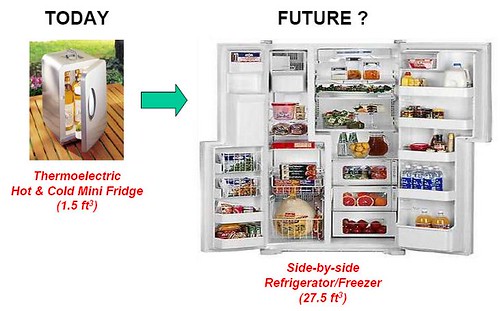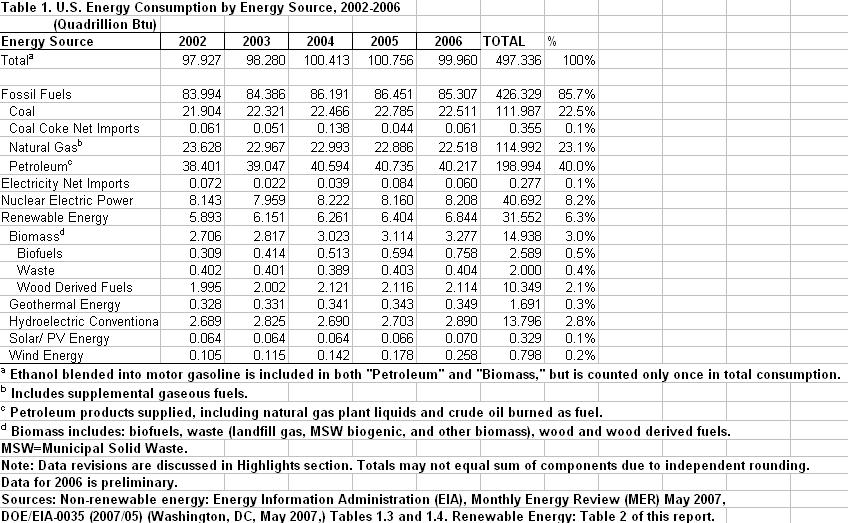
Industrial waste heat is 7 quads in the USA. There is more waste heat from power plants and from cars. Capturing 20% of that waste heat is 1.4 quads every year. 1.4 quads is double all of the wind energy generated in the USA from 2003 to 2006. Further down this article is diagrams and descriptions of the many ways to capture waste heat in cars and trucks (not just thermoelectrics). The positioning of where the temperature differentials are is explained.
This will mean 15% more fuel efficient cars and trucks starting in 2011-2012 and better air conditioners and refridgerators that do not need R134 gas. Applying to our current power plants would be like adding 10-30 nuclear power plants and 150-375 coal plants and 500-1500 natural gas plants that would not use any more fuel because it would be from more efficient use of existing power plats.
UPDATE:
Thermoelectric technology and the Freedom Car project were covered at this site before

MIT Technology Review has coverage
The ZT 1.5 efficiency would translate into a 10 percent increase in the fuel economy of cars if the devices are used to replace alternators in automobiles by generating electricity from the heat in exhaust. The ZT 3.0 materials would be a 15% increase in fuel economy of cars and trucks. The devices could begin selling in 3 to 4 years.
NOTE: If you get up to ZT 5 or so with a cheap enough system then you can replace most of the moving parts of an engine with thermoelectrics. You would generate heat and then use thermoelectrics with no moving parts to convert the heat directly to electricity with higher efficiency.
The new material, thallium-doped lead telluride, has a ZT rating of 1.5 — more than twice that of the previous commercial leader. The researchers believe they can increase it to a ZT of 3.0. ZT is a measure of how good a material is at converting heat to electricity. The chart below shows the differences in efficiency gains from different levels of ZT. The higher the better. The current commercial best is sodium doped lead at 0.71. It is not necessary to understand the science or the principles behind ZT to appreciate it or thermoelectrics.
What’s more important to Heremans is that the new material is most effective between 450 and 950 degrees Fahrenheit (300-600K temp differences possible)– a typical temperature range for power systems such as automobile engines at usable for higher temperature utility power reactors (nuclear and fossil fuel)

The current commercial best ZT figure of 0.7 meant 5-10% recapture of energy from heat at 200-300 degrees temp difference. 1.5 means 12-18% recapture of energy from heat for 300-600K degree temperature differences. ZT at 3.0 for 300-600K temperature differences means 16-25% recapture of energy from heat.
If a ZT of 10 could be achieved for 300-600K differences then it is 26-38% energy recapture. Being able to apply those to current or future nuclear or fossil fuel reactors would be a great boost in energy from fewer power plants.
Waste heat from cars
a big part of 62% of friction and heat losses.
Not just thermoelectrics could be used for capturing waste heat in cars but :
• Electrical Turbo-Compounding (Caterpillar) : 3 to 10% announced fuel economy
• Mechanical Turbo-Compounding : 5 to 10% announced fuel economy
• TIGERS : Turbo-generator Integrated Gas Energy Recovery System : 6% announced fuel economy
• Thermo-electricity : 20% announced fuel economy
• Stirling Cycle in co-generation : up to 40% announced fuel economy but a too low specific power
• Rankine Cycle : Turbosteamer : 17% announced fuel economy
• Organic Rankine Cycle (ORC) : up to 60% announced fuel economy
• Thermo-acoustics : low specific power

Catepillar has a patent for using thermoelectrics in diesel engines. The above diagram shows how they would place a system to capture 265C temperature differential under the truck chassis.
The 1.5ZT material would get 10% of power at 265C degrees of difference.
the 3.0ZT material would get 15% of power at 265C degrees of difference.

Power flows in a car/truck from heat2power
Heat to Power method for capturing waste heat in a car/truck
The heat2power system is based on the use of one or more cylinders for the regeneration of waste heat. These cylinders can be in replacement of the combustion cylinders inside an existing engine or as an add-on module that is connected to the engine by means of a gear set or a belt drive. Also is it possible to have no mechanical linkage between combustion engine and regeneration unit in case the power from the regeneration unit is taken off electrically. In general for low cost of installation and development we recommend OEMs to use an add-on system. In that way the original engine remains basically unchanged.
The thermal power is extracted from the exhaust of the internal combustion engine by means of a heat exchanger. This is an gas-gas heat exchanger operating at high temperatures: up to about 950°C. Basically the heat2power system works like most other thermodynamic cycles : intake and compress a gas, then heat it up and finally let it expand. The difference between an ICE and the heat2power system is that the heat input is not by a combustion inside the cylinder but by heat exchange external to the cylinder.
After the expansion stroke the air is released at low temperatures (250-300°C instead of 600-950°C). This can also be considered as an advantage for military vehicle that require a low thermal profile.
The heat exchanger in the exhaust is placed after the catalyst (gasoline vehicles) or after the particle filter (diesel vehicles). In such manner the exhaust gas after treatment remains unaffected and the combustion engine does not need its tuning to be done all over again. However we recommend to apply thermal insulation of the exhaust manifold and the first part of the exhaust and catalyst/DPF so that a maximum amount of heat is available for the regeneration process.
Industrial waste heat
The amount of process heat that is wasted in the glass, steel, aluminum and chemical industries exceeds 100 TBTU/yr and may be approaching a Quad/yr. In a typical plant, the waste heat available is on the order of 60 Million BTU/hr, or 17.6 MW.
Capturing 20% of that heat is 12 million BTU/hr or 3.5MW.
This material appears suitable for capturing waste heat from our current electrical power plants. Some of those power plants have co-generation where the heat is already used, but many do not capture or use the waste heat. Wide deployment of 20% efficient recapture of waste heat would mean about 5-10% more electrical power from existing sources. For the USA, that is 220-440 TWh of electricity. This would be roughly equivalent to doubling all of the hydroelectric power generated in the USA or a 25-50% increase in nuclear power but without any more fuel use or new plants being built.
List of countries by electricity generation.
World electricity generation at wikipedia
Electricity generation table from 1997-2007 for every country in the world from BP
FURTHER READING
Researchers working towards the Carnot limit of energy recapture form heat
Other researchers are working to commercial inexpensive material with ZT of 1.4

Big energy picture for the USA
World energy usage statistics by BP (48 pages)

Brian Wang is a Futurist Thought Leader and a popular Science blogger with 1 million readers per month. His blog Nextbigfuture.com is ranked #1 Science News Blog. It covers many disruptive technology and trends including Space, Robotics, Artificial Intelligence, Medicine, Anti-aging Biotechnology, and Nanotechnology.
Known for identifying cutting edge technologies, he is currently a Co-Founder of a startup and fundraiser for high potential early-stage companies. He is the Head of Research for Allocations for deep technology investments and an Angel Investor at Space Angels.
A frequent speaker at corporations, he has been a TEDx speaker, a Singularity University speaker and guest at numerous interviews for radio and podcasts. He is open to public speaking and advising engagements.



Comments are closed.